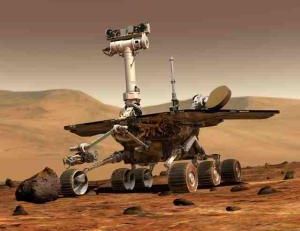
© thinkorthwim.comMars rover Opportunity
In the 7.5 years that NASA rover
Opportunity has spent on Mars, it has uncovered valuable information about the red planet. For instance,
Opportunity initially landed in an ancient lakebed that was rich with water-forming materials, which proved that the now-dry planet was once wet and tropical billions of years ago.
In January 2004,
Opportunity and its twin rover,
Spirit, were parachuted onto opposite ends of the planet Mars. Their purpose was to explore the Martian surface including rocks, craters and hills, record the data to their flash memory, and send it to deep space antennas in California, Australia and Spain.
Unfortunately,
Spirit was the clumsy sibling of the two who would occasionally break down and send "nonsense data" back to Earth. Eventually, it got stuck in a sand pit and fell silent.
Spirit's career officially ended in January 2010 while
Opportunity remained the overachiever.
Now,
Opportunity is continuing its Martian travels by taking on a new area of Mars. Three weeks ago, the rover reached a 14-mile-wide crater called Endeavour, which is an ideal area of exploration because the rocks on Endeavour's rim are from early Martian history and consist of clay materials that form in wet, less-acidic conditions that could be suitable for life. The rim has discontinuous ridges at present, and some have names. A ridge at a section of the rim where
Opportunity landed is named "Cape York," and the gap between Cape York and the next southern rim fragment is "Botany Bay." On the way to Cape York, researchers saw outcrops at Botany Bay "unlike anything
Opportunity has seen so far," and a bench around Cape York's edge looked like sedimentary rock that was cut and filled with materials that could have been delivered by water.
Opportunity has already discovered a new, flat-topped rock in Endeavour that has been informally named "Tisdale 2." It is thought that the rock was brought to the surface after an impact created a crater the size of a tennis court. Researchers have since used Opportunity's microscopic imager, panoramic camera and other instruments to examine the rock.
"This is different from any rock ever seen on Mars," said Steve Squyres, lead investigator for Opportunity at Cornell University in Ithaca, New York. "It has a composition similar to some volcanic rocks, but there's much more zinc and bromine than we've typically seen. We are getting confirmation that reaching Endeavour really has given us the equivalent of a second landing site for
Opportunity."
Opportunity has traveled a total of 20.8 miles since its landing on Mars. Previous to Endeavour,
Opportunity spent two years exploring the Victoria crater. It traveled 13 miles from Victoria to Endeavour.
"We have a very senior rover in good health for having already worked 30 times longer than planned," said John Callas, project manager for
Opportunity at NASA's Jet Propulsion Laboratory in Pasadena, California. "However, at any time, we could lose a critical component on an essential rover system, and the mission would be over. Or, we might still be using this rover's capabilities beneficially for years. There are miles of exciting geology to explore at Endeavour's crater."
NASA plans to launch
Curiosity, its next-generation Mars rover, later this year between November 25 and December 18.
Reader Comments